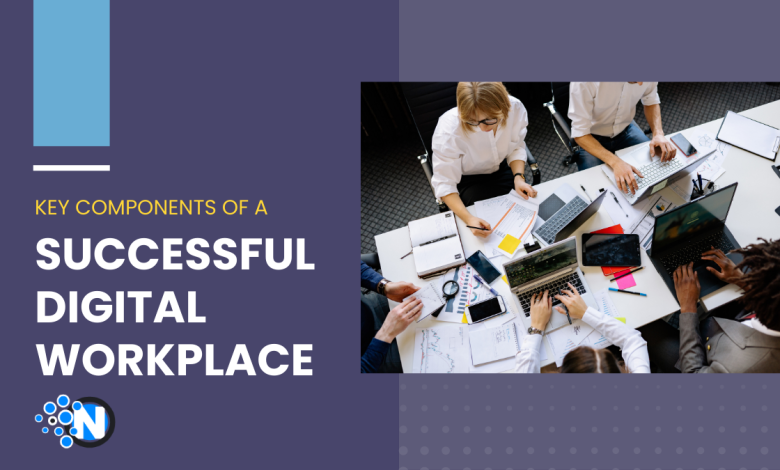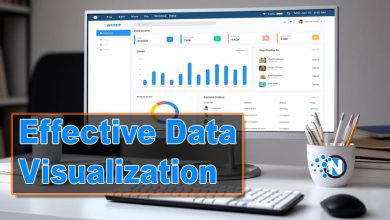Exploring the Key Components of a Successful Digital Workplace

In today’s rapidly evolving work landscape, the concept of a digital workplace has gained significant prominence. A successful online working space encompasses a set of key components that enable seamless collaboration, increased productivity, and enhanced employee engagement.
In this comprehensive guide, we will discuss each of the essential elements. By understanding them, you will learn how to build a digital workspace that empowers individuals and drives business success.
What’s a Digital Workplace Exactly?
A digital workplace is a modern work environment that utilizes digital tools and technologies for tasks and collaboration. Companies choose it for its flexibility, allowing employees to work from anywhere. It enhances collaboration through communication and collaboration tools such as video conferencing and file sharing. It is also cost-effective thanks to the use of cloud-based services and scalable solutions.
Employees working digitally benefit from increased access to knowledge and information. Overall, such workplaces revolutionize work by
- enabling flexibility,
- fostering collaboration,
- streamlining workflows,
- reducing costs,
- ensuring data security,
- and promoting knowledge sharing.
Of course, to achieve all those benefits, a digital workplace must be designed smartly. We will discuss what that means in the next section.
7 Components of a Successful Digital Workplace
1. Collaboration and communication tools
Collaboration and communication tools enable teams to connect, share ideas, and work together seamlessly, regardless of their physical locations. But what are they exactly? One example is instant messaging platforms like Slack and Microsoft Teams. These allow for real-time communication, fostering quick and efficient collaboration. There are also different video conferencing solutions such as Zoom and Google Meet. They enable face-to-face interactions and bridge the gap between remote team members.
File-sharing services like Google Drive and Dropbox, in turn, facilitate easy access and collaborative editing of documents. Teams need them to ensure everyone stays on the same page. All these tools are essential for a digital workplace to function properly.
2. Cloud computing and storage solutions
Cloud computing refers to the delivery of computing services over the Internet. It allows users to access and utilize resources such as virtual machines, storage, and applications on demand. Cloud storage solutions, on the other hand, provide a secure and scalable way to store and access data remotely.
Prominent platforms like Amazon Web Services (AWS), Microsoft Azure, and Google Cloud Platform offer a wide array of cloud computing services, including Infrastructure as a Service (IaaS), Platform as a Service (PaaS), and Software as a Service (SaaS). These solutions eliminate the need for on-site infrastructure, enabling businesses to scale resources dynamically. With their help, businesses can create a flexible and agile digital workplace environment.
3. Project management and task-tracking software
Project management and task-tracking software are tools that streamline project planning, execution, and monitoring. They are important to digital workplaces as they enable teams to stay organized and focused on their goals.
Examples of popular project management software include Trello and Asana, which offer intuitive interfaces and customizable workflows. With these tools, teams can assign tasks, set deadlines, track progress, and collaborate effectively. Task-tracking software, in turn, provides visibility into individual and team productivity. This is essential for accountability and efficient resource allocation.

4. Security and identity management systems
Security and identity management systems are vital components of a robust digital workplace. These systems ensure the confidentiality, integrity, and availability of sensitive data and protect against unauthorized access. Embedded software plays a crucial role in fortifying these systems by implementing security measures within embedded devices. For instance, embedded software enables secure authentication protocols, encryption algorithms, and secure communication channels.
Similarly, access control systems that use smart cards or tokens employ embedded software to manage user permissions and ensure authorized access to sensitive areas or information. By integrating embedded software development into security and identity management systems, businesses maintain a secure workplace environment online.
5. Mobile device management and applications
With the proliferation of smartphones and tablets, businesses must effectively manage mobile devices and apps to ensure productivity and protect sensitive data. Mobile device management (MDM) solutions provide centralized control and monitoring of mobile devices. This means that they enable businesses to enforce security policies, manage applications, and remotely wipe data if needed.
Besides, mobile applications tailored to specific business needs are also required in a digital workplace as they enable employees to work from anywhere. Whether it’s project management apps, communication tools, or custom-built applications, mobile apps streamline workflows and enable real-time collaboration.
6. Knowledge sharing and intranet platforms
Knowledge sharing and intranet platforms provide a centralized hub for employees to access and share knowledge, information, and resources. Intranet platforms, for example, offer a secure and organized space where employees can collaborate and access important documents, policies, and company news. They serve as a digital repository of institutional knowledge.
Plus, intranet platforms often feature discussion forums, wikis, and document management systems. All of these foster collaboration and empower employees to contribute their expertise. With the help of these platforms, businesses can foster a culture of continuous learning. This is why it’s so important for them to be readily accessible to all members of the shared working space.
7. Analytics and data-driven insights tools
Last but not least, analytics and data-driven insights tools are essential for informed decision-making and performance improvement in the virtual workplace. These tools collect, analyze, and interpret data to uncover valuable insights. With robust data visualization capabilities, stakeholders can easily interpret complex data sets.
And with predictive analytics, businesses can make proactive decisions and optimize processes. Simply put, these tools are essential components of a digital workplace because they help businesses be more competitive.
Employee Well-being in the Digital Workplace
In a successful digital workplace, enhancing employee well-being goes beyond implementing technology solutions. It involves creating a supportive and healthy work environment that prioritizes the mental, emotional, and physical well-being of employees. Here are some key strategies for this:
- Encourage work-life balance: Set clear boundaries and expectations. Encourage employees to establish dedicated workspaces, define specific working hours, and take regular breaks to recharge.
- Foster open communication: Cultivate frequent check-ins, virtual team meetings, and one-on-one discussions to ensure that employees feel connected, supported, and heard.
- Provide flexible work arrangements: This may include options for remote work, flexible schedules, or alternative work arrangements that accommodate personal commitments.
- Support mental health initiatives: Providing relevant resources and support. Offer access to mental health resources and employee assistance programs. Encourage regular breaks, exercise, and self-care practices. Promote a culture that destigmatizes mental health discussions and encourages seeking help when needed.
- Promote social connections: Encourage virtual team-building activities and casual virtual hangouts. Provide platforms for employees to connect, share interests, and engage in non-work-related conversations.
- Offer professional development opportunities: Provide access to training programs, webinars, workshops, and online courses. Encourage continuous learning and upskilling.
- Recognize and celebrate achievements: Implement recognition programs, celebrate milestones, and encourage peer-to-peer recognition.
Final Thoughts
In this fast-paced and competitive world, embracing the digital workplace revolution is not just a choice — it’s an opportunity for strategic advantage. Take proactive steps to assess your current strategies, make necessary adjustments, and empower your workforce for a digital future filled with endless possibilities.




